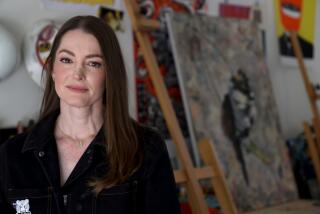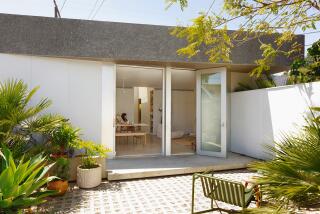Car of the Future Revs Up Today at Design Center
- Share via
Norman Kerchuk hunched over his drafting table and drew the finishing touches on a pair of contoured seats for a cocoon-like automobile interior. The sketch bore little resemblance to the inside of any car on the road today. It wasn’t supposed to.
Kerchuk, a transportation design major at Art Center College of Design in Pasadena, was working on concepts for the interior of General Motors’ Corvette for the year 2000. At the request of GM, students in the advanced course had been assigned to come up with the ideas as a final class project.
As the summer semester drew to a close, Kerchuk and his fellow students scrambled to meet deadlines on their projects and labored over portfolios to show to auto company recruiters scouring the campus for young prospects.
“This is a terrible time right now,” said Kerchuk, a graduating senior from Pasadena. “It’s not uncommon to stay awake for two days.”
For Kerchuk and the other transportation design students, the hard work will probably pay off. About half of the 400 to 500 car designers in the United States and a significant number of those working abroad are Art Center alumni, school officials said.
Although its 70 transportation design majors make up only a small part of its 1,200-member student body, Art Center has earned a worldwide reputation for producing top-notch talent.
“I don’t think there’s anybody quite equal to Art Center,” said Tony Assenza, associate editor of Motor Trend magazine. “Just strictly on the basis of where their grads have gone, they are clearly the leaders in their field.”
Whether a car rolls off the assembly line in Detroit, Europe or Japan, chances are an Art Center-trained designer had something to do with the way it looks, industry and school officials said.
Ford Motor Co.’s adaptation of the aerodynamic look that made its debut with the Thunderbird in 1983 was spearheaded by Jack Telnack, Ford’s chief design executive for North American design and a 1958 Art Center graduate.
“We think we’ve establish aero (design) leadership, and Telnack got us there,” Ford spokesman Paul Preuss said.
The sleek Audi 5000 sedan, which industry observers say launched the current aerodynamic styling trend, was created by a team that included J. Mays, a highly touted 1980 Art Center graduate who now works for an independent firm in Germany.
At the Honda research center in Torrance, a group of designers directed by Charles Allen massaged Doug Halbert’s 1980 sketch into what is now the popular Honda Civic three-door hatchback. Both men came from Art Center.
And in the late 1950s, Toyota Motors sent its former chief designer, Masao Morimoto, to study at Art Center. Morimoto, who retired in 1973, said his studies helped shape Toyota’s future. At Art Center he learned the concept of team design and returned to Japan to supervise creation of the Toyota Crown, the company’s first big success in the American market in the mid-1960s.
“Before that time, design work (in Japan) belonged to one person,” Morimoto said in an interview during a recent visit to the campus. “I learned how to manage a group. It was very valuable experience. Toyota originated its own designs independently, but we wanted exposure to outside ideas. That’s why I came here.”
Morimoto was the first foreign designer to attend Art Center, but not the last. To accommodate foreign auto makers and to cement ties for future graduates with the industry, the school has since set up a one-year program for professional designers from abroad. Last semester, designers from Citroen and Nissan were enrolled.
Citroen sent Erick De Pauw to Art Center to get more artistic training. De Pauw, 32, has a degree in mechanical engineering and had spent nearly eight years designing car interiors before his arrival.
Still Competition
Kaluaki Yamanishi, a 32-year-old Nissan employee who worked on car exteriors for the Z series sports cars for seven years, said he went to Art Center to learn more about interior design.
All of which makes the competition that much stiffer for students with no professional experience. But those students say they welcome the challenge.
“It brings up the level of the class,” said Felix Pabros, a 25-year-old senior. “It’s like playing against a better tennis player.”
Love of the automobile, students say, is their main motivation for choosing their careers. “I’m just a car buff,” Kerchuk said. “I always worked on them. I always had an appreciation for them.”
Despite its peaceful setting in the San Raphael Hills and its creative focus, Art Center’s approach to education is anything but laid back. The school operates three trimesters a year. Students may attend school year-round and can graduate in less than three years, but the normal course takes four years to complete. It carries a sticker price of $2,895 a trimester.
Founded in 1930
In addition to transportation design, the Industrial Design Department offers majors in environmental design and product design. Other departments include photography, communications design and fine arts. The private school was founded in Los Angeles in 1930 and moved to Pasadena in 1976.
Each trimester, students are required to take at least four courses. Most classes last all day. In the transportation design curriculum, subjects range from basic design and structure theory to model making and rendering. Students also are trained to test their models in a wind tunnel at Caltech.
“These students are really entry level designers competing with other recent graduates,” said instructor Richard Hutting, a 1976 Art Center alumnus who heads a design consulting firm. Instructors generally teach one day a week and spend most of their time working in the profession.
Brian Baker, a GM designer who graduated from Art Center last year after transferring there from the Center for Creative Studies in Detroit, said:
“The thing that struck me as different between the school back there and Art Center is how well organized the program is. We’re forced (in Detroit) to interact with engineers and technically oriented people all the time. It’s not (art), and some of that discipline is important. I feel very much prepared by what I did in school. I haven’t run into anything I wasn’t ready for.”
Computer-Aided Design
School officials say they will add seminars and make other changes this year to enhance the program and keep it up to date with technology, including computer-aided design.
Next year, the school plans to open a campus in Vevey, Switzerland, to meet the European demand for design training, a school official said. It will offer programs in transportation and product design, graphics and packaging and advertising design.
Art Center historically has maintained close ties to the automobile industry, said Strother MacMinn, an instructor since 1948. In addition to U.S. auto makers, Citroen, Renault, Volkswagen, Volvo, Saab, Honda and Toyota have sponsored student projects and sent personnel to offer technical assistance and to help evaluate students’ work. Most projects, including the Corvette interior assigned by GM, are academic exercises not intended for practical use by auto makers. Ford, GM and the Chrysler Corp. contributed $2 million toward construction of the Pasadena campus, school officials said.
Those ties can be an advantage when an Art Center graduate goes to work.
“There is a fraternity,” said Baker, 25, who has worked under fellow alumni at RCA, Chrysler and GM. “They say, ‘You’ve been through the same hell we have. Come here, kid.’ And they take you under their wing.”
Less ‘Flash’ Now
Halbert, a 1978 graduate who teaches one day a week when he is not working at Honda’s Torrance facility, said Art Center graduates were once known “for flash and rendering techniques” rather than for design. “That’s changing,” he said.
One of the few criticisms of the institution is that Art Center has been a dominant academic force for so long that its graduates sometimes emerge with a parochial attitude.
“They never really had competition,” Assenza of Motor Trend said. “They thought they had the corner on good taste.”
Times are changing. With entry level jobs paying $27,000 to $30,000 year, and with earnings potential high, automotive design is an attractive profession.
“We are facing more competition than a few years back,” Hutting said. “There now are a number of other schools producing high-level graduates.”
That competition is coming from such schools as the Center for Creative Studies and the Cleveland Art Institute in Ohio, he said.
Nevertheless, said Irv Rybicki, a GM vice president of design who received his training elsewhere, Art Center remains the “Cadillac” of automotive design schools.
Most of the 20 to 25 graduates are expected to get jobs in the industry.
“Art Center,” Kerchuk said, is the place to come.”






